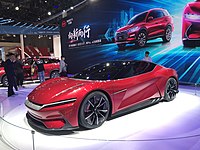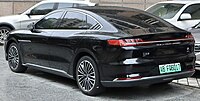|
BYD Han
The BYD Han (Chinese: 比亚迪汉) is a full-size sedan (E-segment) manufactured by the Chinese manufacturer BYD Auto since 2020. It is a flagship model of BYD's "Dynasty Series" passenger vehicles, and was named after the Han Dynasty, the first golden age of Imperial China. Since its introduction, the Han has been available as a battery electric vehicle marketed as Han EV and plug-in hybrid variants. During its introduction in 2020, the Han EV is notable for being the earliest Chinese car that is capable of a 0–100 km/h (0–62 mph) acceleration in around 3 seconds. In 2022, BYD refreshed the Han by replacing the Han DM plug-in hybrid with two variants, the Han DM-i as a efficiency-oriented model and the Han DM-p as a performance-oriented model. In 2025, BYD introduced the Han L, a slightly larger sedan with an all-new ground-up design, updated equipment and more powerful powertrain. It is also available in three powertrain options, the DM-i, DM-p, and EV. ConceptThe Han was preceded by the E-SEED GT concept car, presented at the 2019 Shanghai Auto Show. The concept car is a coupe that features gullwing doors, an all-wheel drive layout, and a 0–100 km/h (0–62 mph) time of less than 4 seconds.[1]
Han (2020)
The first pictures of the production model BYD Han were released in January 2020, prior to its introduction at the planned Beijing Auto Show in April 2020. The model went on sale in China in July 2020.[2] Since 2021, a version dedicated for ride-hailing purposes is available as the BYD e9. Han DMThe Han DM ("dual mode") is the plug-in hybrid variant of the BYD Han. The Han DM is developed on the four-wheel drive DM3 platform, with a plug-in hybrid drivetrain that produces 180 kW (241 hp; 245 PS) from its rear permanent-magnet synchronous motor and 141 kW (189 hp) from the 2.0-litre turbocharged petrol engine, bringing the combined output power to 321 kW (430 hp; 436 PS). It has a 6-speed dual-clutch automatic transmission and can accelerate from 0 to 100 km/h (0 to 62 mph) in 4.7 seconds. Based on the NEDC driving cycle, the combined fuel consumption is 1.4 L/100 km (71.4 km/L; 201.8 mpg‑imp; 168.0 mpg‑US), and the fuel consumption of the internal combustion engine is 5.9 L/100 km (16.9 km/L; 47.9 mpg‑imp; 39.9 mpg‑US).[3] There are two versions of Han DM: the basic "Luxury" model (豪华型) and a more equipped "Majestic" model (尊贵型) with upgraded stereo systems and extra comfort options.
Powertrain
Han EVThe Han EV is the battery electric variant of the BYD Han, and all its models are designed with a 76.9 kWh battery pack, which claims to be rapid-chargeable from 30 to 80% in 25 minutes. The Han EV utilises a new proprietary lithium iron phosphate (LFP) battery design which BYD dubbed the blade battery, claiming to take up less space than a conventional LFP battery of the same energy capacity.[5] The base model Han EV, called the "Extended Range" model (超长续航版), is front-wheel drive with a reported all-electric range (NEDC) of 605 km (376 mi). It is powered by a 163 kW (219 hp; 222 PS) electric motor that can accelerate from 0 to 100 km/h (0 to 62 mph) in 7.9 seconds. There are two versions of this base model: the basic "Luxury" model (豪华型), while the more featured "Majestic" model with extra advanced driver-assistance systems, blind spot detection, better stereo systems and other comfort options. The "Flagship" model (旗舰型) is a four-wheel drive with an additional 200 kW (268 hp; 272 PS) rear motor, bringing the total power output to 363 kW (487 hp; 494 PS), and reportedly can accelerate from 0 to 100 km/h (0 to 62 mph) in just 3.9 seconds.[6] It is rated at a NEDC all-electric range of 550 km (340 mi) with more added features than the "Majestic" model.[7]
Powertrain
2022 faceliftBYD released the updated versions of the Han, which includes the Han EV Founding Edition, Han EV Green Edition, Han DM-i and Han DM-p in April 2022.[10] Han DM-i and Han DM-pThe Han DM-i is the facelift replacing the original Han DM and focuses on fuel economy with four versions available, three of which have a battery range of 121 km (75 mi) and one with a battery range of 242 km (150 mi). The DM-i model has a combined range of up to 1,300 km (808 mi). The Han DM-p (p for 'performance') has a 0–100 km/h (0–62 mph) acceleration time of 3.7 seconds.[11]
Powertrain
Han EVThe updated Han EV features restyled front lower bumper and the updated rear end also shared with the updated DM-i and DM-p variants and was launched with the Han EV Founding Edition, including one variant with a range of 610 kilometres (379 mi) and two variants with a range of 715 kilometres (444 mi).[11]
Powertrain
2024 refreshBYD introduced the 2025 model year Han in September 2024, while reducing its prices. While previously the Han plug-in hybrid and EV version has different front clip design, since the 2025 model year all Han models shares the same front fascia adopted from the Han EV. The plug-in hybrid system of the Han DM-i was upgraded to the latest DM-i 5.0 platform. The 2025 Han is also equipped with BYD's DiPilot 300 advanced driver assistance system with LiDAR and Nvidia Orin-X system-on-a-chip, that offers highway and urban pilot assistance. It also includes the DiSus-C intelligent damping system, which adjusts suspension for comfort or stability.[14][15]
AwardsThe Han EV won the 2021 iF Design Award, the first ever sedan model from a Chinese car brand.[16] BYD e9The BYD e9 was officially launched in March 2021, complimenting other e-series products such as the e2, e3, e5 and e6. It being pitched against medium and large pure electric sedans for the high-end online ride-hailing market. The e9 is largely based on the Han EV and features the Han DM front end styling, with different grille insert and logos. It also uses conventional door handles. The e9 is available with a single-motor two-front wheel drive model with a maximum power of 163 kW (219 hp; 222 PS), a maximum torque of 330 N⋅m (33.7 kg⋅m; 243 lb⋅ft), an NEDC cruising range of 506 km (314 mi), and an acceleration from 0–100 km/h (0–62 mph) in only 7.9 seconds. It takes 30 minutes to charge the power from 30% to 80% with fast charge mode.[17]
Han L (2025)
The BYD Han L was introduced on 17 January 2025, alongside the related Tang L.[19] It is positioned and priced above the existing BYD Han, while the previous Han continues to be offered as a cheaper model. The vehicle is also expected to launch in overseas markets following its domestic release. The Han L is 10 mm (0.4 in) longer, 50 mm (2.0 in) wider, and 10 mm (0.4 in) taller than the standard Han. It offers 1,531 mm (60.3 in) front-row shoulder space and 1,484 mm (58.4 in) shoulder space for the rear passengers.[20] The Han L is described by BYD as a "carrier" of Chinese culture, reflecting the Dynasty Series emphasis on integrating traditional Chinese aesthetics into vehicle design. Designed under the lead BYD's global design director Wolfgang Egger, the model incorporates the "Loong Face" design language that replaced the previous "Dragon Face". Some design elements are chosen for its cultural significance, such as its taillights inspired by a "Phoenix wings", along with details such as the "dragon mustache" chrome element on the front end and brushstroke-shaped D-pillars.[21] The interior of the Han L is also claimed to incorporate influences from traditional Chinese clothing and other cultural elements. Some materials inside adopts bamboo-wood fusion texture. The model is equipped with a refrigerator, fragrance system, wireless charging, and Dynaudio speakers.[21] PowertrainThe Han L offers two powertrain options, battery electric and plug-in hybrid. The electric variant is based on BYD's newest Super e platform with the blade battery. It is available in single-motor and dual-motor configurations, with maximum outputs of 500 kW (671 hp; 680 PS) and 810 kW (1,086 hp; 1,101 PS), respectively. The dual-motor variant includes a rear motor rated at 580 kW (778 hp; 789 PS), which has a peak RPM of 30,000. The rear motor is the world's second most powerful electric motor ever produced, after the Koenigsegg Gemera.[20] The plug-in hybrid Han L is available in DM-i and DM-p variants. The DM-i version pairs a 1.5-litre petrol engine producing 115 kW (154 hp; 156 PS) with an electric motor delivering 200 kW (268 hp; 272 PS), while the DM-p variant adds an additional 200 kW (268 hp; 272 PS) motor. 0–100 km/h (0–62 mph) acceleration times range from 2.7 seconds for the EV model to 3.9 seconds for the DM-p version. Sales
See alsoReferences
|
||||||||||||||||||||||||||||||||||||||||||||||||||||||||||||||||||||||||||||||||||||||||||||||||||||||||||||||||||||||||||||||||||||||||||||||||||||||||||||||||||||||||||||||||||||||||||||||||||||||||||||||||||||||||||||||||||||||||||||||||||||||||||||||||||||||||||||||||||||||||||||||||||||||||||||||||||||||||||||||||||||||||||||||||||||||||||||||||||||||||||||||||||||||||||||||||||

















